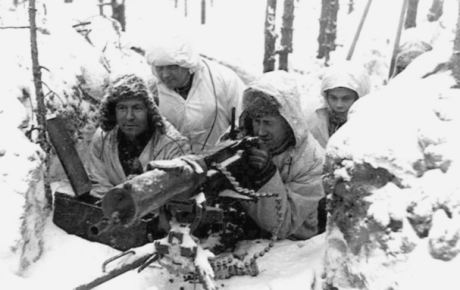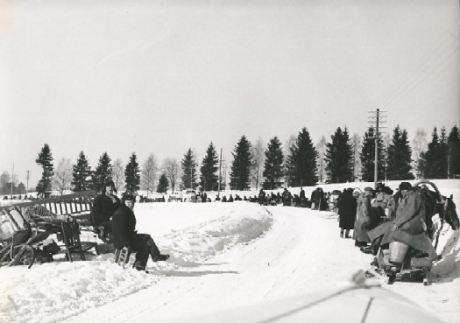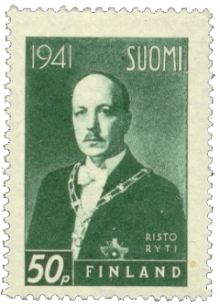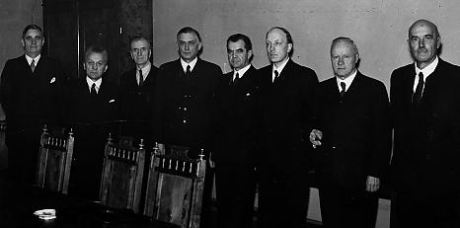7. Finland in the Second World War
Towards the Winter War
Since 1938, international relationships had been considerably strained in Europe. After the Münich meeting, Germany had incorporated Austria and a region from Czechoslovakia that was populated by Germans.
In the spring of 1938, concerned about a potential attack from Germany, the Soviet Union proposed that Finland realign borders at the Karelian Isthmus, lease Suursaari and fortify Åland in order to reinforce Leningrad's security. Negotiations came to nothing. In the spring of 1939, the Soviet Union re-proposed exchanging islands in the Baltic Sea and regions in Eastern Karelia. These negotiations ended without agreement as well.
Early in the autumn of 1939, the whole world was taken by surprise by the news that Germany and the Soviet Union had signed a non-aggression pact. The pact, signed on August 23, 1939, included a secret protocol. It specified that Finland, East Poland, and the Baltic countries belonged to the Soviet's sphere of interest. West Poland belonged to Germany's sphere of interest.
Germany attacked Poland on September 1, 1939, starting World War II.

The pact signed in August 1939 between Germany and the Soviet Union placed Finland in Soviet's sphere of interest.
In the autumn of 1939, Finland and the Soviet Union once more negotiated exchanges of territories, but Finland's government refused to give in. On November 26, 1939, the Soviet Union claimed that Finns had fired cannon shots into the village of Mainila. Finland denied the accusations, but the Soviet Union exploited fake cannon shots as an excuse to attack Finland on November 30, 1939. The Winter War started.
105 Days of Fighting
A state of war was declared in Finland. Mannerheim was appointed the commander-in-chief of the army, and a coalition government was formed. The Soviet Union established a puppet government, The Finnish People's Government, in Terijoki, appointing Otto Wille Kuusinen as its leader. The Soviet Union announced that the Terijoki Government, the official government in Finland, would sign a pact of mutual assistance with the Soviets. The significance of the matter awoke the Finns who, despite the bloody civil war, finally unified against the common enemy.
The Soviet Union armed forces were in a position of strength compared to Finland's armed forces. The main defense line was set at the Karelian Isthmus. Soviet troops were repelled in a number of locations, including Summa, Taipale, Tolvajärvi, and Raatteen tie.

Finnish soldiers during the Winter War (1939 – 1940).
The hard fight of the Finns was admired across the world, but little concrete support was delivered. In January 1940, the Soviet Union gave up the Terijoki government. In February 1940, the Soviet Union launched a massive attack, breaking Finland's defense lines. A request for negotiations was passed via Stockholm.
The Winter War ended when the Moscow Peace Treaty was signed on March 13th, 1940. Finland lost the Karelian Isthmus, Ladoga Karelia, the Rybachy Peninsula, the Salla region, and a number of islands in the Gulf of Finland. Additionally, Hanko Peninsula had to be rented to the Soviet Union as a naval base for 30 years. 400,000 Karelians were evacuated from the territories handed over to the Soviet Union.

Evacuees from Finnish Karelia, after their homes were ceded to the Soviet Union in 1940.
Cease-fire Period
After the Winter War ended, the relationship between Finland and Russia remained tense. Conflicts arose from the terms in the truce, the evacuation of ceded regions, the dismantling of fortifications in Åland, passage to the Hanko base, and the nickel mine in Petsamo.
The Soviet Union tried to influence the nomination of candidates in Finland's presidential elections. Rationing, non-existent international trade, and aggressive actions by communists against the government made the situation difficult. Almost half of the state budget was spent strengthening defense.
Continuation War
During 1939 – 40, Germany was successful in the war, conquering regions in Europe. In the summer of 1940, it was preparing an attack on the Soviet Union, known as operation Barbarossa. It needed Finland as a base and operational territory. Germany was also interested in the nickel mine in Petsamo. The Soviet Union conquered the Baltic countries during the summer months, making Finns concerned about their own fate. Now, Germany and Finland had common interests, opening the floor to unofficial negotiations.
In August 1940, the countries agreed to an arms trade and to letting German troops pass through Finland to Northern Norway. In May 1941, Germany introduced Finland to Operation Barbarossa. Germany and Finland started to devise an attack plan. Finland decided to join Hitler's campaign because the risk of becoming a battlefield for superpowers and of falling into the Soviet Union's arms were considered even worse alternatives.
Germany attacked the Soviet Union on June 22, 1941. According to Hitler's radio speech, Finland was fighting on Germany's side. The government of Finland declared that Finland was neutral, fighting an isolated war. Since German forces were located in Finland, the Soviet Union didn't buy Finland's neutrality claims, especially when the German forces attacked the Soviet Union from Finland's territory. The Soviet Union started bombing Finland on June 25, 1941. The Continuation War started.

Operation Barbarossa launched in the summer of 1941. Finland saw an opportunity to recover territories it had lost.
Finland attacked the Soviet Union in July 1941 in order to recover territories lost in the Winter War. In September, the border of 1939 had been reached. The government decided to continue the attack beyond the border to ensure a strong position in negotiations because they were confident about Germany's war success. England reacted by declaring war on Finland on December 6, 1941.
The conquered East Karelia was incorporated into Finland, and an occupation administration was established in the region. In early December 1941, the attack halted in all fronts. Stationary warfare was conducted until the summer of 1944.

On June 4, 1942, 75-year old Mannerheim received a surprise birthday guest from Germany, Adolf Hitler.
Withdrawal from the War
During 1942 – 1943, Germany's success in the Second World War turned to multiple defeats. The government of Finland didn't believe in Germany's victory anymore, and pursued a separate peace with the Soviet Union. The terms in tentative negotiations in 1943 were so strict that Finland didn't accept them. Germany learned about peace negotiations, and pushed Finland to continue fighting by interrupting food and arms supplies.
The Allies launched an invasion of Normandy on June 9, 1944. Coordinated with the Normandy invasion, the Soviet Union launched a massive attack on the Karelia Isthmus. Finland's defense lines were breaking. At this point in the negotiations, the Soviet Union demanded total surrender from Finland. On the other side, Germany was demanding an alliance in exchange for continuing the supply of arms.
Finland's leaders created a successful diversion. Germany was satisfied with a letter written by President Risto Ryti that convinced Hitler that Finland would continue fighting, and that peace with the Soviet Union was out of the question. Germany increased the supply of arms and assigned more troops in Finland. They helped Finland stop Soviet forces in Tali and Ihantala. Fronts stabilized.
An important defense victory and a shift in the Soviet Union's war effort towards Germany created better conditions for peace negotiations. The Soviet Union didn't demand unconditional surrender from Finland anymore. To ease the situation, President Ryti resigned and Mannerheim was appointed president. He informed Germany that the agreement made by Ryti didn't bind him.

President Risto Ryti (1889 – 1956).
In September 1944, a delegation from Finland traveled to Moscow to negotiate the terms for peace. A cease-fire treaty was signed on September 19, 1944. According to the treaty, Finland lost Ladoga Karelia, the Karelian Isthmus, and Petsamo. Porkkala Peninsula was leased for 50 years as a naval base.
Finland also had to pay 300 million dollars worth of reparations. The Soviet Union also insisted that "war criminals" had to be convicted, "Hitler-minded" organizations disbanded, and communist activity had to be allowed. Military forces had to settle into their peace-time routine, and Germans had to be deported from the country. A finale, called the War of Lapland followed from 1944 to 1945. During the wars, about 95,000 Finns died and 200,000 were wounded.
"The Years of Danger"
During 1944 – 1948, occupation by the Soviet Union and a coup by communists were constant concerns in Finland. Many terms in the cease-fire treaty, such as having Soviet troops in Porkkala, were regarded with worry. The Allied Control Commission settled in Finland to monitor the implementation of the treaty. The commission consisted of Russians and British, and was led by Stalin's right-hand man, Andrei Zdanov.
In order to prevent potential occupation by the Soviet Union, Finland's military forces carried out an extensive secret operation for hiding arms. The operation was exposed in the spring of 1945. Finland was concerned that the Soviet Union would exploit the situation and would occupy the country. Those worries didn't materialize, but the control commission demanded tough actions. Hundreds were apprehended, and about 1,500 were sent to prison.
In the spring of 1945, both the Control Commission and Finnish communists were pushing the government to condemn the state leaders who were in power during the Continuation War. Under pressure, Parliament had to pass an emergency law.
In November 1945, the members of the government and Finland's ambassador in Berlin during the Continuation War were tried and found guilty as war criminals. The harshest sentence, 10 years in the penitentiary, was for President Risto Ryti. The retroactive application of the law, the trial itself, and its outcome were considered to be against the laws of Finland;. but politically, the process was seen as inevitable. Finns regarded the convicted politicians as national scapegoats.

Finnish politicians sentenced to prison for alleged "war-responsibility" by the Soviet-controlled Control Commission after the Continuation war (1941-1944): Henrik Ramsay, Tyko Reinikka, Antti Kukkonen, Edwin Linkomies, J.W. Rangell, Risto Ryti, Väinö Tanner, and T.M. Kivimäki.
The Rise of the Left Wing
After the war, domestic politics significantly shifted to the left. A new communist party SKDL (Suomen Kansan Demokraattinen Liitto, Finnish People's Democratic Union) was founded, but it was controlled by SKP.
Two communists were appointed members of the Paasikivi government in 1944. In the parliamentary elections of 1945, Paasikivi appealed to voters to elect new politicians. Communists won 49 of 200 seats in the elections. In 1946, Paasikivi was elected as president, and a number of communists were appointed members of government.

President J.K. Paasikivi (1870 - 1956) with his daughter Annikki and wife Alli.
With access to the Home Office, communists could control Valpo, the state police, and snoop on right wing activities. They also organized strikes and demonstrations, tried to socialize production facilities, and managed to get their own people into key administrative positions, including, at Yle (Public Broadcasting Corporation) and at the National Board of Education. Finns were worried that the development was taking them along the same path as in the people's democracies in East Europe.
Finland’s foreign policy had a primary goal after the war to establish good and trustworthy relations with the Soviet Union. Paasikivi's goal was to acknowledge the Soviet Union's status as a superpower and to pay attention to its interests in order to avoid military threats. Finland followed the Soviet Union's cue and didn't accept Marshall aid. The relationship stabilized after the Paris Peace Treaty was signed in 1947, and the Control Commission left the country.
YYA Treaty 1948
As the cold war developed, the Soviet Union wanted to enter into YYA Treaties (Pacts of Friendship, Co-operation, and Mutual Assistance) with Eastern European states. Finland signed the treaty as well, but managed to negotiate different terms than the other countries. Finland had the right to remain neutral, and outside the conflicts of superpowers. Finland wasn't obligated to form a military alliance with the Soviet Union, and the Soviets couldn't make a one-sided decision to demand military consultation on potential threats approaching the Soviet Union via Finland.
During the YYA Treaty negotiations, a potential communist coup concerned the people in Finland. A coup didn't happen, but the rumors turned voters away. Communists were rejected both in labor union and parliamentary elections. Social Democrats retained their control of the labor union, and communists were kept from joining the government. They didn't manage to control the state administration, and the Soviets didn't sufficiently support them to gain total power in Finland.
The YYA Treaty ended the "Years of Danger". The pact determined the principles of Finland's foreign policy until the Soviet Union's collapse in 1991.
Comprehensive War Reparations
Finland was told to pay 300 million dollars of reparations to the Soviet Union in the Cease-fire Treaty. The Soviet Union wanted the reparations delivered primarily as products of the metal industry, such as machines, ships, and railway equipment. Additionally, wood, paper, clothing, and shoes were exported.
Affordable loans from the United States and Sweden allowed Finland to acquire raw materials and to build production facilities, helping to pay for reparations.
In the early years, 15% of the state budget was spent on war reparations. Nonetheless, Finland eventually benefited, because it had to build factories, new production facilities, and power plants. The number of available industrial jobs increased, so that Finland developed into an industrialized country in the 1950s.

Finnish icebreaker and harbor tug S/S Turso was built in 1944, and given to the Soviet Union as war reparation in 1945.
Reconstruction
The daily life of Finnish families stabilized after the war. Maternity and mother-child clinic laws were passed, and the child allowance system was developed. The birth rate was remarkably high. During a few years (1945-49), over 100,000 children were born each year, creating an age group of baby-boomers in Finland. New homes, schools, and kindergartens had to be built.
Over 400,000 Karelians moved to Finland after Karelia was lost in the war. Farmland was expropriated for them. New farms were created for veterans as well. The number of small farmers increased and the population in the countryside increased. The state secured low interest rate loans for citizens in order to ease the housing shortage in the cities. In a few years, a large refugee and population problem was solved.